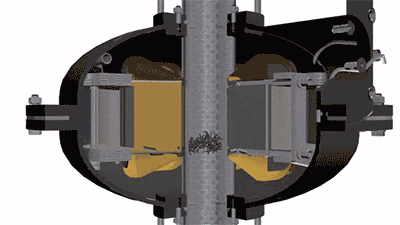Pigment dispersion is another field of application for vortex layer devices. This is a promising area, because many industries consume plenty of pigmented paints and varnishes: paints, enamels, primers. They are indispensable for mechanical engineering, radioelectronics, shipbuilding, furniture industry, manufacturers of household appliances, etc.
Pigmented paints and varnishes are used for ensuring anti-corrosion protection and imparting a good and marketable appearance to products. In terms of structure, such materials constitute highly concentrated suspensions of pigments and fillers in solutions or dispersions of film-forming substances. In this case, the task of adjusting the decorative properties of coatings through opacity and color is assigned to pigments. In addition, pigments can influence other properties of paints and varnishes:
- deformation and strength;
- insulating;
- anti-corrosion;
- adhesive.
In paint production, the largest amount of electricity (at least 70% of total energy consumption) is spent on dispersion of pigments and uniform distribution thereof in solutions, dispersions, or melts of film-forming agents. It is associated with features of the equipment used in addressing this task.
Pigment dispersion equipment
Let us discuss the main devices for pigment dispersion during the production of paints and varnishes. They can be conveniently divided into two large groups:
- Machines with rigidly mounted working media the motion speed of which does not depend on the viscosity of processed pigment paste. These include roller machines, rubber mixers, high-speed disc machines and agitators.
- The devices where the working media move freely in the pigment paste, and their motion speed depends on the paste viscosity. These include ball, bead, and sand mills, as well as attritors. The listed devices operate with maximum efficiency only at a certain optimal value of viscosity.
In a ball mill, only the upper rolling layer of balls performs well; therefore, in order to improve its efficiency, it is required to involve a much greater volume of balls or to expand the rolling surface.
The main disadvantage of attritors is severe wear of grinding media and housing. They are not suitable for dispersing the pastes with abrasive pigments contained and for producing light-colored enamels.
Bead mills have become widely used in paint pigment dispersion. In this kind of equipment, the grinding media are balls made of glass, steel, porcelain, tungsten carbide, zirconium oxide, and other wear-resistant materials.
Obtaining low-viscosity pastes may also use colloid mills where a pigment dispersion enters the space in front of the rotor. Centrifugal forces push the dispersion into a narrow conical gap between the rotor and the stator where the pigment is dispersed when exposed to shear forces. Due to the high rotation frequency of the mill shaft, a severe wear of its working members is observed.
The dispersion degree which means how well the pigments have been ground is of great importance for uniform distribution of pigment in the film-forming agent. Not all the listed devices are capable to ensure fine grinding. And even if they are capable, it requires additional pigment processing which results in high electricity consumption.
Two-stage pigment dispersion is practiced where at the first stage, the pigment is ground, for example, in a bead mill to the particle size of 30–40 microns, and then regrinding is applied by means of ultrasound. The question arises: is it possible to carry out efficient pigment dispersion in one device with low electricity consumption? You will find the answer in the next section.
Pigment dispersion by means of vortex layer devices

When exposed to a magnetic field, the interfacial tension of solutions and emulsions decreases, the activation energy of viscous flow declines, and the wettability of solid ingredients improves. The dispersion process is considerably accelerated, or it becomes possible to increase the optimal degree of filling the pastes with solids.
The efficient use of ultrasound for pigment dispersion is noted as well. During ultrasonic processing, degradation of particles results from the deformations caused by a sound wave spreading in the particle and a pressure drop at the particle-liquid interface. The cause may also include collisions of particles of different sizes entrained and not entrained by the sound wave.
At large amplitudes of acoustic pressure, there occurs cavitation which means the formation and collapse of bubbles where a great amount of energy is released which also has a destructive effect on processed substance.
Now imagine that several devices and process steps are not required for pigment dispersion using these physical processes. In vortex layer devices, all these processes occur simultaneously which contributes to the most efficient pigment dispersion in a liquid medium.
А vortex layer device consists of a cylindrical operating chamber filled with ferromagnetic particles (needles) and a rotating electromagnetic field inductor. Driven by this field, the ferromagnetic particles move along complex trajectories and constantly collide with one another, with the operating chamber walls, and with particles of processed substance.
At the same time, in the operating chamber, there occur physical processes discussed above that affect the size reduction of pigment particles and improve the efficiency of pigment dispersion:
- each ferromagnetic particle becomes a mini-source of ultrasonic vibrations due to magnetostriction;
- due to high local pressures in a liquid medium, there occurs cavitation;
- a rotating electromagnetic field created by the inductor;
- a direct impact effect of ferromagnetic particles on the substance, etc.
- The feedstock is pumped into the device operating chamber where it is intensively processed, dispersed, and drained through the outlet.
A few minutes normally suffice for efficient dispersion which is achieved due to the intensifying effect of ultrasonic vibrations, cavitation, a rotating electromagnetic field, and other factors.
Advantages of a vortex layer device (AVS) in the pigment dispersion process
A vortex layer device compares favorably with other mills and mixers used for pigment dispersion due to the following reasons:
- Higher dispersion quality: pigments are perfectly added to the film-forming agent. As a result, the quality of finished paints and varnishes improves.
- Low power consumption. GlobeCore produces vortex layer devices of AVS-100 and AVS-150 types with the power consumption of 4.5 and 9.5 kW respectively.
- Dispersion intensification. Efficient pigment dispersion is achieved in a matter of minutes.
- Versatility. A vortex layer device can be used to efficiently disperse pigments of various presentation forms: granules, powder, liquid, etc. Furthermore, both “dry” and “wet” grinding can be performed.
- Easy integration into operating technological lines. The device has compact dimensions and requires no special pedestal for installation. It can be quickly integrated into the operating technological line instead of a mill or a mixer.
- Convenient maintenance. The device has no friction components that require constant servicing.
- Long service life of the device. For some technological processes, the service life of a vortex layer device reaches 30–40 years.
For advice regarding the introduction of the devices into your technological process, please contact our professionals using some of the contact details which you can find in the appropriate website section.



